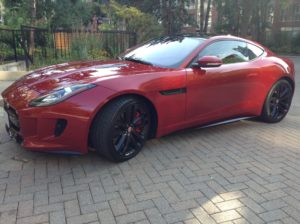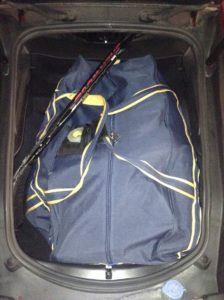Some cars you marry. Others you just take for a fling.
Members of the latter category may try to fool you into thinking they belong in the former. Comfort and safety features may abound, from heated leather seats to a heated leather flat-bottomed steering wheel to blind spot alerts to parking assist and beyond.
Take a good look at Jaguar’s 2017 F-Type S. Which category do you think this coupe falls into?

The first time I drove the F-Type, I was seduced. I still have a thing for this car, but time has helped settle the initial infatuation. That’s why I’m glad I can now take a more balanced look at a car I still adore.
First impressions
This is the car you want to be seen driving. The long, low profile draws attention just about everywhere, and from directions you might not expect. One driver of a Jeep, his leg resting outside where the door should have been, gave me a thumbs-up as I passed him on a highway. A view of the F-Type’s tapered back end probably softened any blow to his ego when I blew by him.
Even standing still, the sensuous curves, the 20” black wheels, the black hood details on the Italian Racing Red body of my tester combined with all other styling details to create a feast for the eyes. My dad didn’t want to go for a spin when I brought it to my parents’ place, but he did want to look under the hood and stand around talking about the car until I pointed out I had to get some work done. I think he snuck peeks at it afterwards.
You can impress a passenger (this is a two-seater) in several ways. Door handles sit flush to the door, not unlike those of a certain electric car manufacturer. Press the button in a handle and it swings out diagonally (unlike the handles of the aforementioned manufacturer) ready to be pulled. Locking the car is as simple as pushing the handle back into the door.
Interior cabin lighting starts with the illuminated “Jaguar” on the door sill and continues with accents tastefully distributed in the predominantly carbon fibre and leather “Jet” interior.
The panoramic sunroof in my tester makes the cabin feel much more open than it would if all you have to look through is the windows.
Turn on air conditioning and watch the centre part of the dash come up to reveal centre vents. James Bond would approve.
Have your passenger use the mirror concealed in the very narrow sunshade to look out the rear window as you pass a certain speed on the highway. At that certain speed, your passenger will see what you see in your rear-view mirror – a small rear wing deploys. Jaguar thoughtfully includes a button in the cabin that raises the spoiler when the car is parked so you can clean it. I only used this button to play show-and-tell.
Hockey bag test
The luggage compartment fits a full-sized hockey bag, longitudinally, with room for another half-bag beside it. The sticks poke into the cabin, but if you can fix the blades just right in the rear, you can keep the butt ends from swinging around in front.

Driving
Once you’re done impressing your passenger, you can impress yourself.
My favourite lighting accent, one your passenger might not notice, is the Start Stop Engine button, just ahead of the gearshift. When I stepped into the car for a nighttime jaunt, I noticed it blinked slowly at me. I imagine it was telling me to get down to business.
Press the button, and the 380 hp supercharged 3.0L V6 growls and barks to life, ready to meet your need for speed in a very musical way. Jaguar offers two engine sizes, each with two different power output ratings: 3.0 V6 340HP; 3.0 V6 380HP; 5.0 V8 550HP; and 5.0 V8 575HP.
If the throaty roar that hits your ears when you start the engine isn’t enough, and you want more roar when you step on the accelerator, Jaguar obliges with an Active Exhaust button next to the gear shift. This button shows an icon that resembles the two tailpipes that stick out from the centre of the F-Type’s rear. Active Exhaust works valves somewhere in the exhaust to give you even greater auditory thrills.
The Active Exhaust feature only works when the Jag is in Dynamic drive mode. That button, also near the gearshift, shows a checkered flag. Its overall effect on the car could best be described as unleashing the cat. If you thought the F-Type was ready to pounce before you hit that button, hang on tight.
The Dynamic Drive mode button sits next to a button for Rain/Ice/Snow, a button I can’t help but think owners would be loathe to ever need. (Note: button layout differs depending on whether the F-Type has an automatic or manual transmission. And I’m losing track of how many buttons this car has to control performance.)
More important than any of that is the 6-speed manual shift in this coupe. Powering through the gears using three pedals and a shifter makes for a more visceral experience than that of the automatic, even with its paddle shifters, and that’s saying something. I know one F-Type convertible owner who, when he bought his car, wanted a droptop more than a manual transmission, though he coveted both. He might be considering a trade-in now that the convertible ships with a manual transmission too.
There’s little to worry about going through curves at speed thanks to the Sport suspension with Adaptive Dynamics. I didn’t try to drift the Jag, but I was perfectly confident throwing it around at higher velocities than I normally would. At times when I did this, my girlfriend noted, with her white knuckles, the solid hand grips on the door handle and to the right side of the centre console.
Long-term potential?
For all its great technology and potential for fun, I can’t say the F-Type is the marrying kind.
Let’s start with the obvious: revving any of the engines Jaguar fits into this model will cost you dearly at the pump.
Jaguar thoughtfully adds an intelligent stop/start engine feature to help you save gas. When you’re at a stop, move the gearshift out of gear and take your foot off the clutch pedal. The engine shuts itself off until you step on the clutch again – unless it has to run systems like air conditioning. A/C kept the engine running for much of the time I had it. The engine would shut off for maybe a minute at a time most days. (Wastrels will be glad to know they can turn off intelligent stop/start at the touch of a button.)
The stiff leather performance seats, adjustable as they are, aren’t for everybody. Side bolsters will keep you in place as you twist through your favorite country roads, but there’s little use for them on daily commutes. An oblong, non-adjustable headrest emerges from the seat between my shoulder blades. Call it a consequence of my height, but this bump can get annoying over time. A bright spot here is the thoughtfulness of putting seat adjustment controls on the door near the dashboard, where they’re easy to see and use.
The hard seats may amplify the stiff ride in this car. You can take corners at speed and never worry about losing grip, but in day-to-day driving that grippy suspension means you’ll feel every manhole cover, expansion joint and gnat your wheels hit.
Low ground clearance made me learn to take certain bumps at an angle to lessen the chances of scraping the “ground effects” under the front of the car.
Shifting the gears myself seemed so right. This is a great gearbox. But each time I did I bumped my lower arm against my side of the centre console. Also, if I left my hand on the shift lever, I could feel buttons like the one for Dynamic drive mode under the heel of my hand. Fortunately the only one I would touch is the electronic brake lever, and pushing it down deactivates it, so there was no hazard there.
The shift lever, when in an even-numbered gear (2, 4 or 6) also blocks the driver’s view of buttons like the one for Active Exhaust. This isn’t the case with the automatic transmission variant, where buttons are arranged a little differently. To be fair, the buttons you can’t see aren’t buttons you need to use regularly while driving.
A water bottle in the cupholder got in the way of my shifts, a problem I’ve experienced in other cars, I admit.
Speaking of the cupholders, this tight little car doesn’t give much room for storage. There’s no compartment for sunglasses. The glovebox is a decent size, but the centre cubby containing two USB ports would not hold any of today’s larger-format smartphones, and there’s nowhere else but the cupholders to store them.
Actually, there is one place: a “pocket” above and to the right of my right shoulder. It’s a few inches deep and has no cover. Reaching it involves enough torso twisting that only the limber need try.
You can close the luggage compartment using a button on the underside of the hatch. Locking the car as a whole still entails using the key fob or the side door handles. A “close and lock everything” button next to the “close hatch” button would add the convenience one expects from a vehicle of this calibre.
You won’t want for technology in this cabin, though a few things could stand improvement.
The navigation system’s address entry proved a little pokey. Also, the volume knob for the 700+ watt Meridian sound system sits just ahead of the shift lever. It’s inconvenient to twist one’s wrist to get around the shifter in any gear, but especially in third, as well as first and fifth.
When I look at the F-Type, I wonder whether anybody who owns one is NOT a fair-weather driver. Sure, you have a driving mode for snow and ice. You also have heated seats and steering wheel (with the button for the latter conveniently located on the wheel). But the low ground clearance and overall beauty of this set of wheels makes me cringe at the thought of taking the F-Type for a spin during a typical Canadian winter. I can’t be the only driver who thinks this way.
Pricing
The 2017 F-Type S starts at $89,500. My tester, with options, charges and taxes, ships for $106,725.
Conclusion
This might seem foregone, but the logical side of me has to relegate the F-Type to the fantasyland of forbidden adventure. Not that I’m averse to reviewing it every so often.
Fortunately for Jaguar, plenty of well-heeled auto enthusiasts think with their emotions first. Were I well-heeled, I might join their ranks.